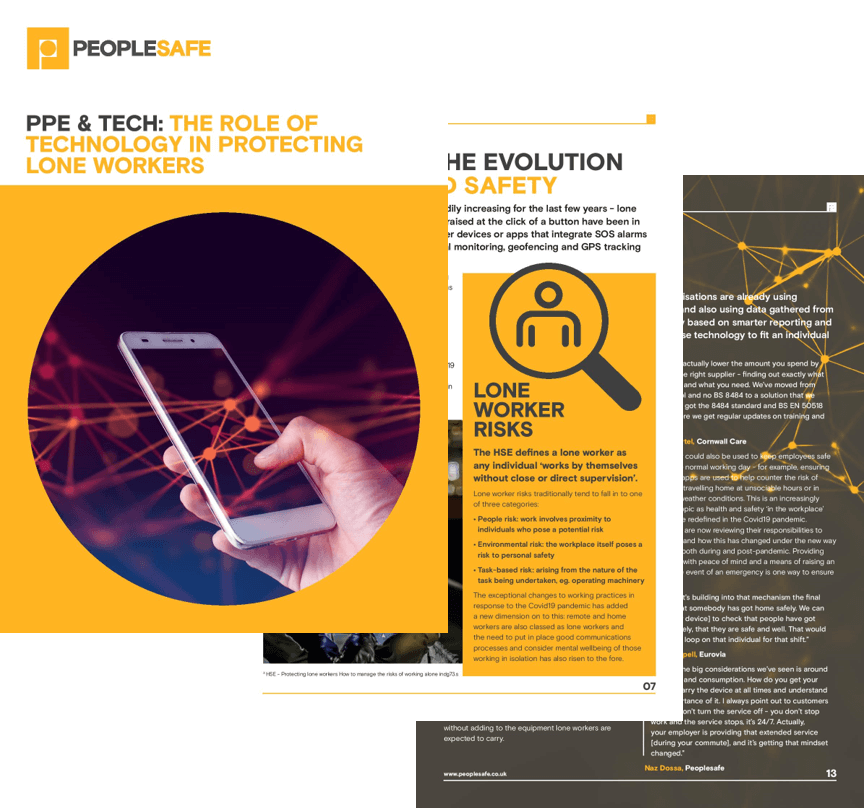Importance Of Technology In Protecting Worker Safety
New working practices necessitated by COVID-19 have led to an unprecedented rise in the number of employees now working remotely or alone. And with more firms announcing plans to roll out flexible or hybrid working, temporary measures are becoming permanent practices; potentially changing the working environment forever.
We worked with over 120 health and safety professionals to find out what impact COVID-19 has had on lone working, and how firms are responding to changes. The results confirmed an increase in lone workers in the field or on site, in addition to a newly remote workforce. 71% of firms stated that they plan to invest in lone worker technology and smart PPE within the next 1 – 3 years, with 78% going on to say that they’d welcome a recategorisation of lone worker protection as PPE to boost adoption and improve safety standards.
The full findings can be found in our white paper, “PPE & Tech: The role of technology in protecting lone workers”, published today, which predicts an evolution of PPE to PPET: Personal Protective Equipment & Technology.

A new definition of lone working
In March 2020, the HSE published a timely update to their lone worker guidance. This new guidance placed a more explicit responsibility on firms for the safety of any worker who worked without close or direct supervision.
With the advent of the first COVID-19 lockdown, the term ‘lone worker’ suddenly referred to a much larger community of workers, including those operating in isolation or out of earshot under social distancing measures and those forced to work remotely when they would usually have been in an office setting. In terms of employee health and safety, COVID-19 created a raft of new and heightened challenges. On top of the need to supply workers with the right COVID-related PPE came a responsibility to monitor and manage the increased risks inherent in lone working; ranging from accidents and injury, through to concerns about mental wellbeing.
The tensions created by the pandemic have also contributed to an increased risk from unpredictable members of the public, with workers in care, retail and telecoms amongst the most affected and the hospitality sector reporting a 200% increase year-on-year in incidents during the summer of 2020.
The evolution of PPE
With so much to consider, businesses keen to maintain high health and safety standards are turning to technology to address the challenges of protecting a dispersed workforce. Our survey found that many already treat lone worker technology as personal protective equipment (PPE), and many firms now view technology as the enabler of a remote working model, allowing them not only to protect their employees from physical harm but also to increase communication and monitor the mental wellbeing of their remote workforce.
Integration with systems and processes is seen as critical to ensure a successful technology roll out: smarter devices are also being relied upon to fulfil multiple purposes, from boosting connectivity across an increasingly remote workforce and providing incident response and support to vulnerable workers during (and outside of) working hours. Firms are also using this technology to gather trend data, helping them to anticipate risks and reduce incidents, marking a clear evolution in its use from a reactive tool used post-incident to one that can also help to prevent incidents.
Maximising protection with embedded systems
76% of the firms we spoke to have reviewed their risk assessments since the first lockdown of 2020 and many are not only using technology to offer greater support to lone workers, but are also using the data gathered from connected devices to identify gaps in health and safety protocols and develop more informed activity. This kind of approach will be critical to providing comprehensive and reliable protection for lone workers and to fulfilling the duty of care imposed by the new HSE guidance.
While more than half of the firms we spoke to (51%) plan to increase their use of smart PPE within the next 1-3 years, this is actually only part of the puzzle. For some businesses, large scale culture change, education and training will be needed before employees can be provided with robust and meaningful protection – that not only ensures they are safe on the job but also that they return safely to their base or home once work is completed.
At Peoplesafe, we’d like to see PPET more widely adopted and properly integrated into working practices as they evolve, so that lone workers can consistently get the protection they deserve. For more information on how changing working practices are transforming the role of health and safety and the use of technology, please download the full report: PPE & Tech: The role of technology in protecting lone workers




